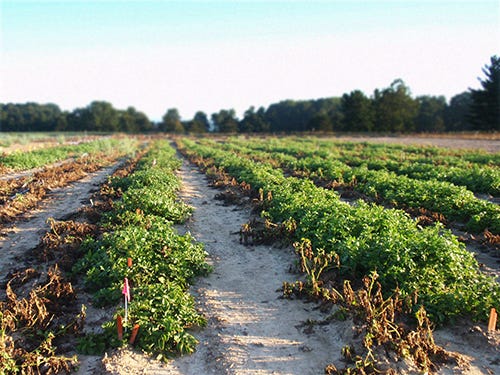New potato variety from Simplot offers late blight resistance as well as beneficial traits for growers, processors and consumers.
May 8, 2019

The Food & Drug Administration has completed its food and feed safety assessment of the J.R. Simplot Co.'s second generation of Innate potatoes.
FDA concluded that these Russet Burbank Generation 2 potatoes are not materially different in composition, safety and other relevant parameters from any other potato or potato-derived food or feed currently on the market. Simplot will still need to complete its registration with the Environmental Protection Agency for these potatoes before introducing them for sale in the U.S. marketplace.

Photo: J.R. Simplot Col/Businesswire.
The FDA safety consultation was voluntarily requested by Simplot and comes shortly after the U.S. Department of Agriculture also deregulated the same potatoes. These federal clearances involved a thorough technical review and a public comment period that drew the support of leading potato research universities in the U.S. and Europe.
Simplot reported that its second generation of Innate potatoes contains four benefits of relevance to potato growers, processors and consumers: (1) reduced bruising and black spots, (2) reduced asparagine, (3) resistance to late blight pathogens and (4) enhanced cold storage capability. These benefits were achieved by adapting genes from wild and cultivated potatoes.
Academics consulted by Simplot estimate that the Innate variety's late blight resistance trait can result in a 25-45% reduction in fungicide applications annually to control late blight. Reduced asparagine means that accumulation levels of acrylamide can be reduced by as much as 90% when these potatoes are cooked at high temperatures. In addition, lowered reducing sugars enable cold storage at 38°F for more than six months without the buildup of sugars, which maintains quality and could not be achieved previously.
Based on these academic estimates, if all Russet Burbank potatoes in the U.S. had Innate generation 2 traits, potato waste (in the field and during storage, packing, retail and foodservice for fresh potatoes) could be reduced by about 986 million lb. In addition, carbon dioxide emissions could be reduced by 146 million lb., water usage could be reduced by 17 billion gal. and a total of 495,000 fewer pesticide acre-applications would be needed.
Duane Grant, potato farmer and owner of Grant 4D Farms in Rupert, Ida., called the second-generation Innate potato "a major advancement in the potato industry. Late blight disease can and does wreak havoc on organic and conventional potato crops, and now we have an effective solution that should reduce fungicide use and reduce the millions of pounds of wasted potatoes each year.”
Late blight, the disease responsible for the historic Irish potato famine, is caused by a fungus-like pathogen and still has the potential to devastate world potato crops. Innate Generation 2 potatoes contain a gene from a South American wild potato species that provides natural resistance to certain strains of the pathogen.
“We're excited to continue momentum on our Innate technology platform,” said Haven Baker, vice president and general manager of Simplot Plant Sciences. “In our first two generations, we have addressed the issues of plant disease, health and quality by harnessing the strongest traits within the potato family, and we're now set to address global potato challenges.”
Simplot noted that Innate Generation 2 potatoes remain regulated as plant-incorporated protectants by EPA, and there will be no promotion, distribution or sale of these potatoes until they are registered by EPA.
Simplot is a privately held agribusiness based in Boise, Ida., with an integrated portfolio that includes phosphate mining, fertilizer manufacturing, farming, ranching and cattle production, food processing, food brands and other enterprises related to agriculture. Its major operations are located in the U.S., Canada, Mexico, Australia and China, with products marketed in more than 40 countries.
You May Also Like


.png?width=300&auto=webp&quality=80&disable=upscale)
